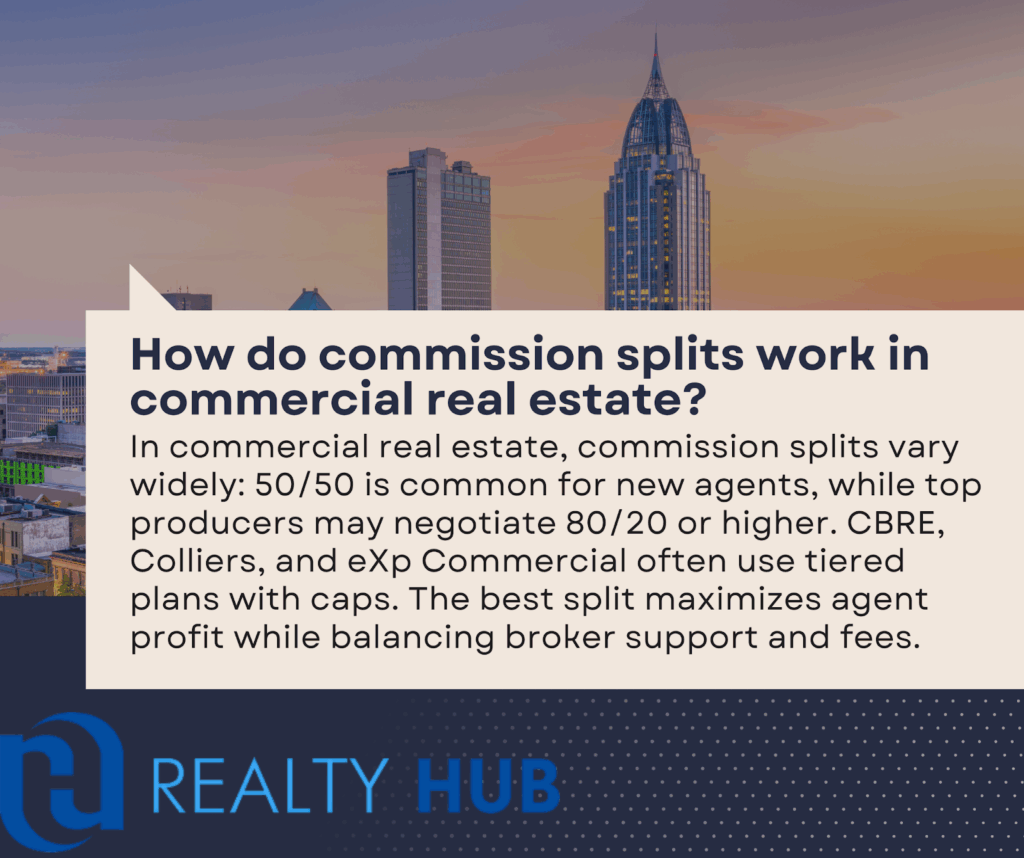In commercial real estate, commission splits vary widely: 50/50 is common for new agents, while top producers may negotiate 80/20 or higher. CBRE, Colliers, and eXp Commercial often use tiered plans with caps. The best split maximizes agent profit while balancing broker support and fees.

Here’s the truth: no one should give away their hard-earned commission forever. Splits may seem harmless early in your career, but over time, they drain thousands, often tens of thousands, of dollars from your income. At Realty Hub, we’ve stripped away the traditional brokerage layers and built a flat-fee model designed to maximize what stays in your pocket.
If you’re simply curious and want a quick explanation of how commercial real estate commission splits work, you’ve already got it. But if you’re serious about growing your income, protecting your time, and finally taking control of your business, keep reading.
We’re going to break down every major commission model, how top firms operate, and much more.
How Commercial Real Estate Commission Splits Work
At its core, every commercial real estate commission starts with a simple formula: the broker earns a percentage of the transaction value, and that commission is then divided between the brokerage and the agent according to a pre-arranged split.
But while the math is simple, how those percentages are divided is where things get far more complicated.
The property type, market, transaction size, agent experience, and brokerage model all factor into the final split an agent receives.
In commercial transactions, splits apply differently depending on who the agent represents:
- Buyer Representation: Agents representing the buyer typically receive a share of the total commission offered by the seller’s broker or, in some markets, negotiate their fee directly with the buyer.
- Tenant Representation: Tenant reps often negotiate commissions with landlords or property managers; these fees are typically baked into the lease structure.
- Landlord Representation: Listing brokers secure full commissions from the property owner, then split that commission with any cooperating brokers who bring tenants or buyers.
- Dual Representation: In some deals, agents represent both parties, keeping the full commission, though this requires careful disclosure and compliance.
The challenge in commercial real estate is that there is no single “standard” structure. Even within the same city, two deals of similar size can pay out very differently depending on which brokerages are involved and how the commission agreements were negotiated upfront.
That inconsistency can make it hard for agents, especially newer ones, to know whether they’re truly getting a fair deal.
Common Commission Split Models
50/50 Split (The Classic Entry Point)
For many agents starting in commercial real estate, the 50/50 split is where they begin. The broker keeps half, the agent keeps half. In exchange, the brokerage typically covers office space, administrative support, marketing materials, and back-office systems.
While simple and easy to calculate, this structure becomes less attractive as agents grow their book of business. Top producers often reach a point where handing over half their earnings feels increasingly unnecessary.
Flat Rate Commission Plans
Flat rate models offer brokers predictable revenue, regardless of deal size. The brokerage takes a set cut, perhaps $5,000 per transaction or 30% of every deal, no matter how much commission is generated. For example, on a $10,000 commission, both the agent and broker would each take $5,000.
While some agents appreciate the predictability, flat rates can frustrate high producers who generate large commissions but still give the same flat portion to the house.
Tiered Commission Structures
Tiered splits are designed to reward productivity. As agents close more deals, their split improves. A typical model might start with a 50/50 split for the first $100,000 in commissions, shift to 75/25 for the next $100,000, and finally reach 90/10 beyond $200,000 in annual production.
While these models incentivize growth, they also introduce complexity, requiring careful tracking of production levels, resets at the end of the year, and sometimes additional desk or admin fees built into the higher tiers.
100% Commission Models (Modern Virtual Brokerages)
Virtual brokerages like Realty Hub have redefined commission structures entirely. Agents keep 100% of their commission and pay only small, flat transaction fees. This structure puts maximum earning power directly in the agent’s hands, especially for experienced producers who no longer require heavy brokerage oversight.
At Realty Hub, for example, agents pay just $100 per year to maintain their membership, and $100 per transaction when deals close. There are no franchise fees, desk fees, or escalating splits.
Real Worries Agents Have
Commercial real estate commission splits don’t just create financial decisions, they often create friction. We’ve heard concerns from agents repeatedly:
- Will residential agents with commercial experience be unfairly shorted on splits?
- Why do some commercial brokers insist on paying residential agents less, even when the residential agent performs competently?
- Why aren’t splits always 50/50 when both sides contribute equally to the transaction?
- Should buyers start paying their agents directly to avoid these disputes entirely?
- Why is there no consistency across markets, even for similar deal types?
These tensions are very real, especially for agents who cross between residential and small commercial transactions. Hybrid properties, like owner-occupied warehouses or small medical offices, blur the lines between commercial and residential representation.
In many cases, residential agents bring emotional, highly motivated buyers who may even pay above market value for location or convenience. Yet despite bringing value, these agents often face pushback from commercial brokers who argue they lack deep knowledge of SNDA clauses, estoppels, or tenant improvement structures.
What Is the “Best” Commission Split?
The question every agent asks, What is the best commission split?, doesn’t have a one-size-fits-all answer. The truth is, the best commission split is the one that fits your business model, your production level, and your long-term goals.
Here’s what every agent should evaluate:
- Your Production Level: If you’re consistently closing high-value commercial deals, high splits (or 100% models) protect your earnings. Low producers may benefit initially from broker-provided resources at a higher split.
- Broker Support Offered: Do you need hands-on mentorship, in-house marketing, or corporate lead generation? Or do you primarily need compliance coverage, transaction processing, and quick broker access on demand?
- Office Overhead vs. Virtual Freedom: Brick-and-mortar brokerages come with desk fees, office maintenance, and franchise charges. Virtual models like Realty Hub eliminate those layers, allowing agents to work remotely and reduce costs.
- Cap Structures: Some brokerages limit how much they keep through commission caps. Once you hit the cap, you retain 100%. But hitting the cap may require significant upfront production.
- Revenue Share Options: Companies like eXp offer revenue share incentives for recruiting agents. While lucrative for some, it depends on your interest in building a downline network.
- Long-Term Career Growth: Think beyond this year’s transactions. Which model gives you the most sustainable income as you scale your personal brand and build repeat business?
How Much Do Commercial Real Estate Agents Make?
Income in commercial real estate varies dramatically. According to multiple industry benchmarks:
- New Agents may earn between $40,000–$80,000 annually while building their client base.
- Experienced Agents commonly reach six figures, particularly once repeat clients and investor relationships develop.
- Top Producers in high-volume markets or niche sectors can exceed $300,000 to $500,000 or more per year.
The biggest variable impacting these income levels? Commission splits.
An agent on a 50/50 split earning $400,000 in gross commissions takes home only $200,000 before additional desk, franchise, or marketing fees. The same producer under a 100% commission model with flat transaction fees could walk away with nearly double that amount. Every percentage point matters when you’re closing large commercial deals.
By retaining full commission, agents have more flexibility to reinvest profits into business growth, client acquisition, and marketing. This snowballs over time, accelerating career momentum while protecting long-term income stability.
7 Tips to Maximize Your Earnings as a Commercial Agent
Whether you’re just starting or already producing at a high level, these proven steps can significantly increase your bottom line:
- Negotiate Your Split Early and in Writing: Don’t assume your brokerage’s default split is non-negotiable. Secure clear terms upfront.
- Understand All Hidden Fees: Beyond the split, assess desk fees, franchise royalties, marketing costs, and admin charges that erode your income.
- Leverage Virtual Brokerages to Cut Costs: Models like Realty Hub eliminate physical office overhead while preserving full compliance support.
- Invest Commission Savings into Lead Generation: Use saved dollars for targeted marketing, CRM systems, and digital prospecting tools that drive deal flow.
- Build Niche Expertise: Specializing in high-demand sectors (medical offices, industrial, retail strip centers) allows you to command higher fees and dominate specific market segments.
- Cultivate Referral Relationships: Consistent referrals from other agents, business owners, and past clients stabilize long-term deal flow.
- Adopt Technology for Deal Transparency: Platforms that offer real-time commission tracking, expense reporting, and client management help streamline operations and eliminate financial surprises.
Why Many Agents Are Moving to 100% Commission Brokerages
There’s a reason more agents are questioning traditional brokerage models. The math simply doesn’t favor them long-term.
- Cost Savings Add Up Quickly: What starts as “only” a 20% split can amount to tens of thousands lost annually once volume grows.
- More Freedom, Less Oversight: Experienced agents don’t need daily supervision or hand-holding. They need flexibility to run their business as they see fit.
- Virtual Models Offer Support Only When Needed: At Realty Hub, we provide immediate access to broker guidance and full compliance infrastructure, without daily quotas, mandatory meetings, or unnecessary bureaucracy.
With Realty Hub, your costs are clear: $100 per year to maintain your license, and $100 per transaction. That’s it. No desk fees. No franchise royalties. No creeping overhead. The result? Agents who keep what they’ve earned and finally experience the financial control they’ve been seeking since entering this industry.
Choose the Model That Matches Your Business
There is no universally perfect commission split. Every agent’s ideal structure depends on their:
- Production level
- Desired support structure
- Tolerance for office overhead
- Long-term financial goals
Traditional firms offer brand recognition and resources, at a price. Tiered models reward production but often reset annually, eroding long-term gains. 100% commission models like Realty Hub maximize take-home earnings while providing the compliance systems agents still need to operate legally and efficiently.
When comparing options, don’t just evaluate the headline split. Look at your true net income after all fees, expenses, and deductions. Too often, agents focus on the split while ignoring desk fees, franchise dues, tech charges, and administrative costs that chip away at their earnings.
The Easiest Way to Keep 100% of Your Commission
You’ve worked too hard to give away your commissions indefinitely. Every year you stay on a traditional split model, you leave thousands of dollars on the table, money that could be invested directly back into growing your business, improving your marketing, or building true financial security.
At Realty Hub, we’ve built a different kind of brokerage:
- Flat-Fee 100% Commission Model: You keep 100% of your hard-earned commissions with only $100 per year and $100 per transaction.
- Compliance-First Support: Stay fully compliant with licensing and transaction regulations without unnecessary oversight or bureaucracy.
- Freedom Without Sacrifice: No desk fees, no franchise dues, no quotas. Full access to broker support when you need it. Independence when you don’t.
If you’re serious about maximizing your income, reclaiming your time, and taking full ownership of your commercial real estate career, we invite you to see how Realty Hub’s model aligns with your business.
The freedom you imagined when you first got licensed is waiting. 👉Join Realty Hub today.


